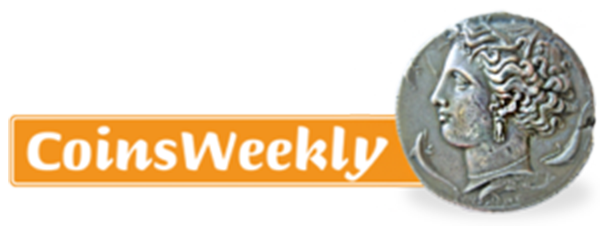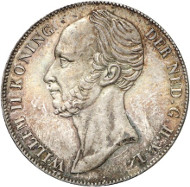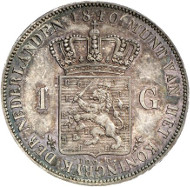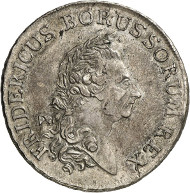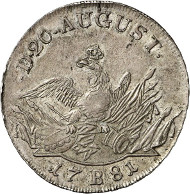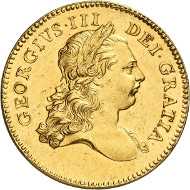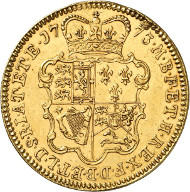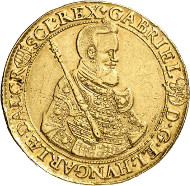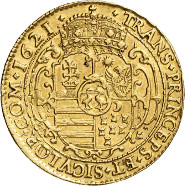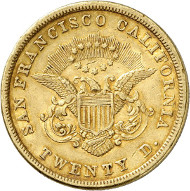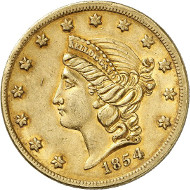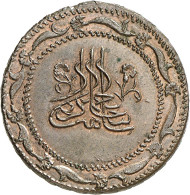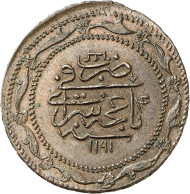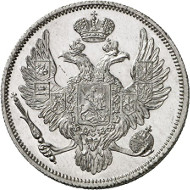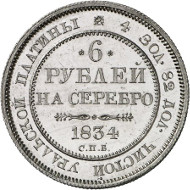28-01-2015 – 01-01-1970
Berlin Auction 2015
The Berlin Auction of Künker: One Highlight After Another.
1,073 lots. Total estimate: 6.5 million, total hammer price: 8.6 million. The Berlin Auction of Künker on January 29, 2015 on the occasion of the World Money Fair proved that the market for fresh material in highest quality is more than strong.
For more than 60 years, the Horn Collection had been untouched before it was auctioned for the benefit of the Horn Foundation. It was hardly surprising, therefore, that the splendidly preserved items obtained record prices.
Lot 647: NETHERLANDS – KINGDOM. William II, 1840-1849. 1 gulden 1840, Utrecht. Schulman 518. Ex Horn Collection. Extremely rare. Extremely fine to brilliant uncirculated. Estimate: 30,000,- euros. Hammer price: 120,000,- euros.
A case in point is the gulden from 1840, struck in Utrecht under the rule of William II. Just two examples of this rare coin type had been known so far. What was more, the specimen from the Horn Collection was magnificently preserved, extremely fine to brilliant uncirculated, albeit it came with a pre-sale price tag of impressive 30,000 euros already. In retrospect, every collector would have praised himself lucky if he had got this specimen at that price, with the hammer price reaching 120,000 euros, hence four times its estimate.
Lot 37: HORN COLLECTION – PRUSSIA. Frederick II, 1740-1786. Reichsthaler 1781 B, Breslau. Kluge 325.2. Old. 483. Extremely rare. About extremely fine. Estimate: 20,000,- euros. Hammer price: 55,000,- euros.
Admittedly, here we have singled out the most extreme example. Yet many other coins from the Horn Collection likewise exceeded their estimate considerably. Examples are the Prussian speciesthaler 1755 of Frederick the Great (estimate: 40,000 / hammer price: 67,500 euros) or the extremely rare reichsthaler 1781 from Breslau of this ruler (estimate: 20,000 / hammer price: 55,000 euros).
Lot 41: HORN COLLECTION – BRUNSWICK-WOLFENBÜTTEL. Julius II, 1568-1589. Löser of 10 reichsthaler 1574, Heinrichstadt (Wolfenbüttel). Welter 548. Extremely rare. Very fine to extremely fine. Estimate: 50,000,- euros. Hammer price: 95,000,- euros.
The Brunswick löser rose to the top as well: the löser of 10 reichsthaler from 1574 in the weight of 9 reichsthaler brought 95,000 euros (estimate: 50,000 euros) while the löser of 6 reichsthaler from Zellerfeld dating from 1634 sold for 42,000 euros (estimate 25,000 euros).
The success of an auction can be reckoned from the time it takes. It became clear to everybody long before noon that it would take some time before getting to lunch. And most hotel guests had already finished dinner in the hotel lobby, while in the auction hall there were still bids being placed.
The fact is that a heavy bidding-fight takes time. And the Berlin sale saw many bidding-fights. 900 bidders took part in the auction sale – by sending a bid, at the telephone or coming personally. They all made sure that hardly any item was left unsold and that most lots exceeded their pre-sale estimate.
Lot 600: GREAT BRITAIN. George III, 1760-1820. 5 guineas 1773, London. Pattern with plain edge. Extremely rare. Extremely fine. Estimate: 100,000,- euros. Hammer price: 120,000,- euros.
We have seen already at the Künker October Sale that Great Britain is extremely high in demand. In Berlin, that trend was confirmed. The extremely rare pattern of the 5 guineas piece from 1773 had been estimated at 100,000 euros, it brought 120,000 euros. To that, “Una and the Lion” almost played second fiddle, even though the hammer price of 85,000 euros (estimate: 40,000 euros) was nothing to sneeze at, either.
Lot 757: HUNGARY – TRANSSYLAVANIA. Gabriel Bethlen, 1613-1629. 10 ducats 1621 KB, Kremnitz. Fb. 357. Very rare. Very fine to extremely fine. Estimate: 30,000,- euros. Hammer price: 95,000,- euros.
A high flyer was a 10 ducat piece from Transsylvania bearing the portrait of Gabriel Bethlen, struck in Kremnitz in 1621. It did leave its estimate of 30,000 euros behind, to obtain more than three times that sum, 95,000 euros.
An even greater surprise was the result an Egyptian gold medal reached, minted in 1927 in commemoration of the King of Egypt visiting Belgium. The splendid specimen in its original case realized 55,000 euros (estimate: 20,000 euros).
Lot 802: USA. California. 20 dollars 1854. Issued by Kelogg & Co., San Francisco. Fb. 37. Rare. About extremely fine. Estimate: 5,000,- euros. Hammer price: 20,000,- euros.
The small selection of 20 early private gold coins from the US American gold mining areas had been estimated at a total sum of 175,000 euros. The hammer prices added up to about twice that sum, 327,000 euros. Some items rose exponentially, like the octogonal 50 dollar bar, marked by Augustus Humbert (estimate: 15,000 / hammer price: 34,000 euros) or the rare 20 dollar 1854 by Kelogg & Co. (estimate: 5,000 / hammer price: 20,000 euros). The 10 dollar piece from 1849, issued by the enigmatic Miner’s Bank (estimate: 20,000 / hammer price: 42,500 euros), should not be omitted either.
Lot 1072: RUSSIA – CRIMEA. Shahin Giray ibn Ahmad Giray, 1191-1197 AH (= 1777-1783). Piaster (poltina) 1191 AH (= 1777), Jahr 4, Baghce Saray. Pattern in copper. Retowski 118. Ex Horn Collection. Extremely rare. About brilliant uncirculated. Estimate: 1,000,- euros. Hammer price: 42,000,- euros.
Speaking about incredible prices – let’s move on to Russia. The weak rouble notwithstanding, it still applies: perfect Russian coins of great rarity have no price. The buyers keep on bidding until they get them. The same goes for fractions and bronze coins. The grivennik from 1705, produced in the Kadashevsky Mint at Moscow, rose from 4,000 to 32,000 euros, the 5 kopecks in copper, struck in St. Petersburg in 1867, rose from 2,000 to 15,000 euros, and the pattern for the rare piaster from the Crimea from 1191 AH (= 1777) rose from 1,000 euros to incredible 42,000 euros.
Lot 931: RUSSIA. Nicholas I, 1825-1855. 6 roubel platinum 1834, St. Petersburg. Bitkin 60 (R3). Only 11 specimens struck. With expertise of Igor Shiryakov, State Historical Museum Moscow. Proof. Estimate: 100,000,- euros. Hammer price: 120,000,- euros.
Of course individual roubles and gold coins realized significantly higher prices, like the roubel from 1714, from the Red Mint at Moscow, that brought 110,000 euros (estimate: 40,000 euros), the roubel from St. Petersburg from 1741 with its price of 60,000 euros (estimate: 20,000 euros), and the 6 roubel in platinum from St. Petersburg from 1834 that sold for 120,000 euros (estimate: 100,000 euros) in the end.
You may find all results online.
The next auction will be conducted between March 9 and 13, 2015. The relevant auction sale catalogs may be ordered at Künker, Nobbenburgerstraße 4a, D-49 076 Osnabrück; phone +49 (0)541 / 96 20 20; telefax: +49 (0)541 / 96 20 222; or by writing an email.


